1994 French Grand Prix race report - two into three won't go
Damon Hill and prodigal Nigel Mansell dominated qualifying for Williams, but come the race smart tactics made it business as usual for Michael Schumacher and that Benetton
If ever a 1994 race must have made Max Mosley rub his hands with glee and say ‘I told you refuelling would create some great race strategies,’ then the French GP at Magny-Cours was it.
Of the front runners, nobody spent more time in the pits than Michael Schumacher, three pit visits accounting for a cumulative stop time of 1m 10.767s. But there’s nothing wrong with that, so long as your car is the fastest when it’s running. Schumacher’s was, and Benetton also sold Williams a great dummy with its fuel stop strategy.
Most teams were expected to make two stops (bar Christian Fittipaldi and Footwork who always seem to love the one-stop plan, although this time Blundell joined him). Certainly, Williams wasn’t expecting Benetton to throw in that extra one.
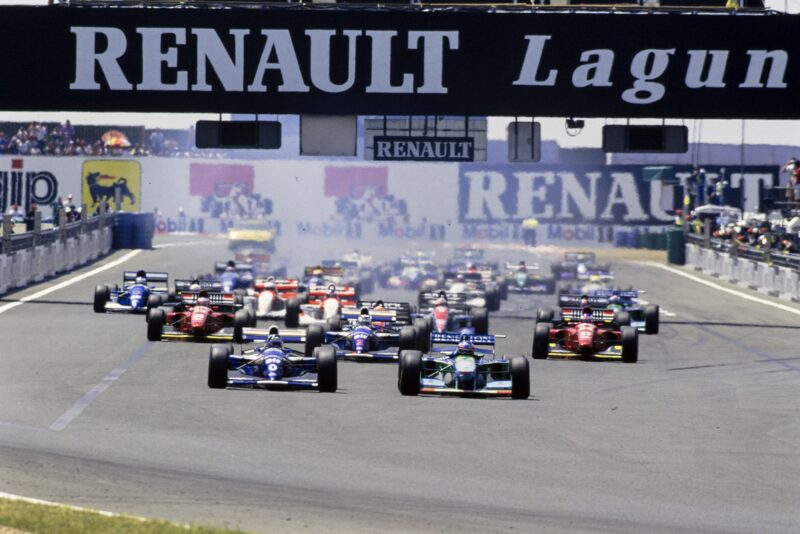
Damon Hill and Michael Schumacher fight into turn one for the lead of the race
Motorsport Images
“I had a look at strategy on Saturday, and that seemed just the way to play it,” said Technical Director Tom Walkinshaw. If the race surprise was thus on the Didcot team, qualifying had been the other way round. On Friday, as Nigel Mansell played himself back into the F1 groove with seventh place, Schumacher comfortably outpaced Damon Hill and the two heavily revised Ferraris of Gerhard Berger and Jean Alesi. When you watched the Mild Seven Benetton out on the circuit it was obvious why. Where the Ferraris slithered and slipped that day (and both ultimately came to undertray and barge-board damaging grief at the quick chicane), and where Hill struggled a little in the final sector of the course with a Williams that otherwise was far happier on a much less bumpy than usual surface, Schumacher’s mount was in a class of its own. He seemed to be able to place it anywhere he liked on the track, and through that quick chicane its grip and stability were breathtaking.
Which is what made Saturday so surprising. Remember Estoril last year, where Schumacher and the team just couldn’t get a handle on the B193B’s set-up? It was the same story in Magny-Cours. The morning’s free practice had only just got underway when Schumacher had a very hairy off-course moment and narrowly avoided hitting the tyre wall as the B194 bumped over the grass and gravel. And when Michael limped back to the pits he was far from happy, gesticulating wildly to Benetton boss Flavio Briatore and race engineer Pat Symonds. What had happened was that the team had tried a new pad material which heated up and snatched just as Schumacher was changing down a gear. That locked the rear wheels and off he went.
Then, in qualifying, neither car nor driver seemed to have the same poise, at a time when the Williams pilots were really finding their rhythm. Benetton had changed the set-up but it didn’t work, and Michael stayed with it just that bit too long.
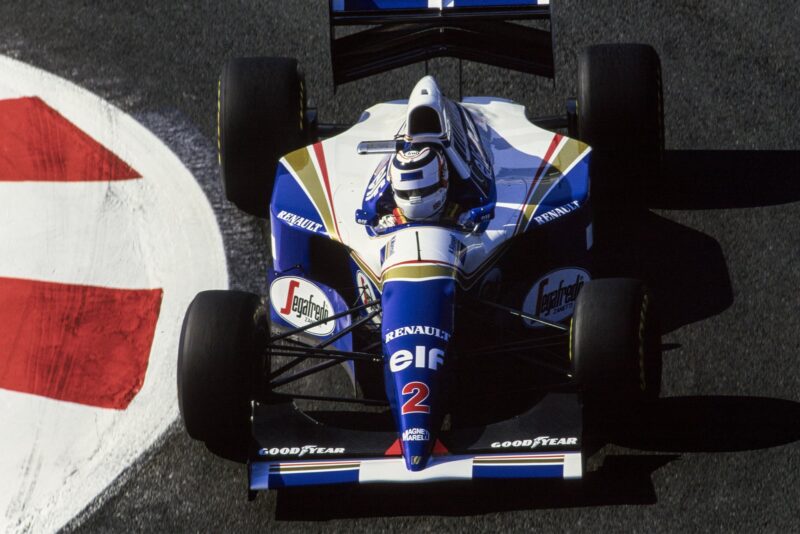
Nigel Mansell on his return to Formula 1
Motorsport Images
This day Mansell looked far more confident, far more his old self. The 1992 World Champion was fastest by a fraction from Hill in the morning, and after Alesi and then Schumacher had improved the latter’s best Friday time when qualifying began, Mansell was the first to dip into the 1m 16s bracket with 1m 16.987s. That performance by the Prodigal Son was to spark off the most exciting qualifying session of the season.
Once the track had been cleared after Jos Verstappen drove his Benetton into the pit wall, Hill struck back at Mansell with 1m 16.609s to go fastest, but later Mansell worked down to 1m 16.393s and it looked to be all over, just like a replay of his old battles with Nelson Piquet. Hill made a mess of the first corner as he clipped the kerb, and some changes to the car didn’t feel right, so he aborted his next try, and there were only 10 minutes remaining when he went out again. And this time, despite a big twitch in the chicane, he beat Mansell’s time with 1m 16.282s to claim the third pole position of his brief F1 career. At the time we thought the stage was set for a cracking race, most likely between Hill and Mansell, with Schumacher trying to keep the hungry Ferraris at bay. We were wrong.
Hill made an excellent start as Mansell lagged slightly later describing it as the second best of his year but Schumacher simply came bursting between the two of them without the slightest trace of wheelspin and was already well in the lead by the time they turned into the first corner.
“I was surprised, to be honest,” said Damon afterwards. “He was going past me at a hell of a rate.”
“I really couldn’t have made a better start,” said Michael happily. “It was perfect.”
Some cynics thought it was a bit too perfect, giving rise to all sorts of uncharitable speculation.
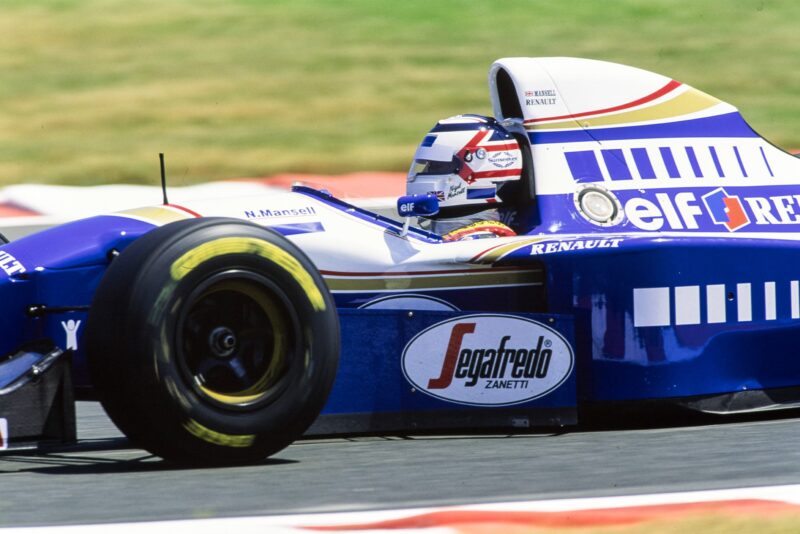
Mansell in the Williams
Motorsport Images
Sensing this later, the German made some further revelations. “We have done some development work on our clutch, which wasn’t very good when we went to this new clutch at the beginning of the season. It is now giving us much better starting performances, as you can see.”
Later still, others would point to the Benetton’s lower fuel load, although that barely held water since both he and Hill came in for their first stops on lap 21, which suggests they had similar fuel loads aboard for their first stints, and that it was not until the crucial second stint that the Benetton had the serious weight advantage. Whatever, Mansell slotted into third place from Alesi, Berger and Irvine, but Barrichello was pushed down to 10th by Frentzen and Hakkinen, with Brundle next from Verstappen, de Cesaris, Panis, Katayama, Martini, Fittipaldi, Herbert, Comas, Bernard, Morbidelli, Beretta, Blundell (who’d lost five places), Alboreto, Zanardi, Brabham and Gounon.
Hill kept the Benetton honest until their stops, but Mansell soon faded and was clearly holding up Alesi as Berger moved clear of the Frentzen/Irvine fight to establish himself in a worthy sixth. Irvine, too, it transpired, was looking for one stop to his team-mate’s two.
Besides Verstappen, who was cut off by Brundle, damaged his nose and made a spectacular pit entry on lap 12 for repairs, Mansell was the first to stop, on lap 19. He dropped to sixth, Alesi making his own stop on lap 19 and beating the Williams back out to resume in fifth. Then Schumacher, Hill and Berger all came in together at the end of lap 21, and this is where it began to go wrong for Williams. At that stage Damon had been only 1.4s adrift, but in total time he lost two seconds to Schumacher, which would transpire partly to be because he took on less fuel.
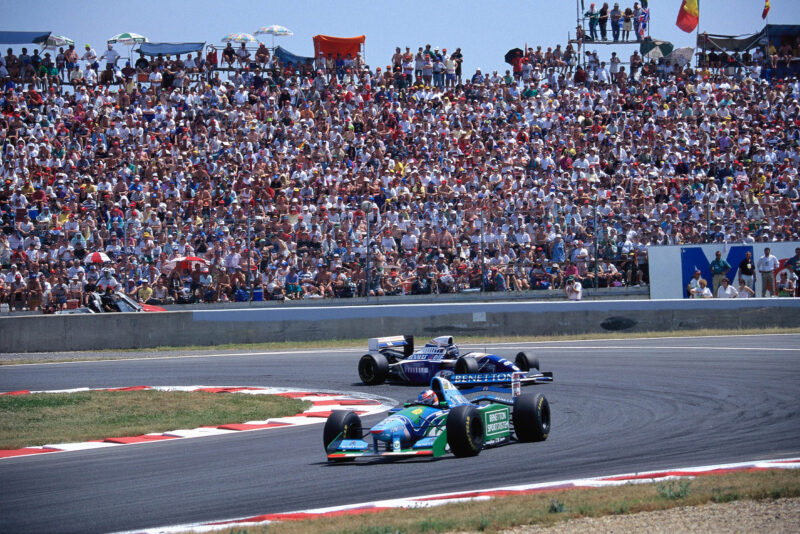
Schumacher leads Hill
Motorsport Images
Damon’s problems in his second stint were compounded by a set of tyres on which he felt his Williams to be less well balanced. Where before he’d been pushing Schumacher into small errors, now he was dropping away with understeer. By the time Schumacher came in for the second time, on lap 37, the gap was 7s. Hill then reversed that until his own second stop on lap 45, when again he lost time to Benetton. This time his overall call was 1.2s slower. Only later, however, when Schumacher came in again at the end of lap 55, this time when nursing a whacking 29.7s lead, did the real reasons for his sudden mid-race speed become fully apparent. And by then it was all too late. Game, set and match to Benetton, and this at a race where Hill desperately needed to win to keep his slim championship chances alive.
There was no joy for Mansell, either. Clearly working on a three-stop plan of his own, he had climbed back to fourth behind Schumacher. Hill and Alesi when he pulled in at the end of lap 29. But when he resumed back in sixth place and again made no impression on Barrichello, and when he occasionally passed the pits resting his head a little, it began to seem that he was tiring in the searing heat. The ambient temperature was over 30, the track temperature therefore over 47 and only the drivers knew what it must be like in the cockpits.
Shortly afterwards Mansell had a stroke of luck and moved up two places without passing anyone when Alesi made a hash of the chicane before Lycée on the 41st lap. The Ferrari spun across the gravel, showering the track with debris, and then Jean spun it again deliberately to face in the right direction. Unfortunately, when he went to restart he moved straight into Barrichello’s path, and the resultant collision put them both out.
Jean blamed his spin on overheating rear tyres which were promoting oversteer, and appeared to have little remorse for poor old Rubens, who was into a drive that certainly deserved points. With Irvine already gone with transmission problems, it was a bitter blow to the Sasol Jordan team to lose out in such a manner.
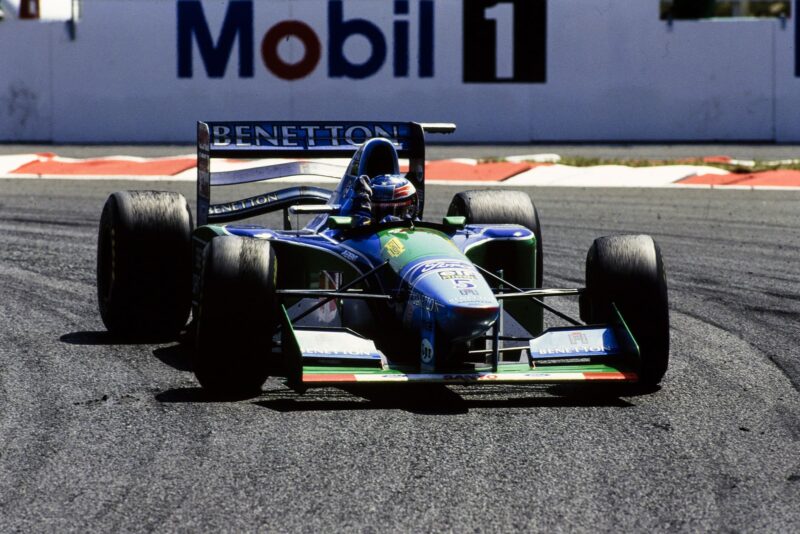
Schumacher celebrates his French Grand Prix victory
Motorsport Images
“He just didn’t measure the distance between us,” lamented Barrichello. “I’m so disappointed. I was sure that today we could go to the podium.” Mansell did not have much time to savour his fortune, as on lap 46 he cruised to a halt at the Adelaide hairpin, where Zanardi had earlier abandoned a burning Lotus, Brundle (while outpacing Hakkinen) a blown-engined McLaren, and Morbidelli had taken off Panis. The official line was that the Williams’ transmission had suffered hydraulic pump failure, but the way that Mansell sat for a long while in the cockpit before the car was eventually pushed away prompted plentiful speculation that he had simply found racing the latest breed of F1 car an even tougher proposition because of the heat and the on-off nature of the higher G-loading than driving his Lola IndyCar. Berger, who had come up to third on Alesi’s demise but had dropped to fourth with his second fuel stop, had been sitting right behind his old team-mate. “I could see from his pit boards that he would soon be coming in,” said Berger with his usual naughty schoolboy smirk, “but I thought I would sit behind and push him, just to tire him out a bit more. . .” The Austrian finished a relatively satisfied third, the new Ferrari 412T1B proving the superiority of its aerodynamics and high-speed balance, but now in need of the 75 degree V12 engine (briefly tried in Imola) that it would try in testing prior to Silverstone.
By lap 46, then, there were fewer candidates for fourth place. Heinz-Harald Frentzen currently held it, but then immediately made his second stop and surrendered it to Mika Hakkinen, who himself had only handed over a position with his own pit call the previous lap. The French GP, of course, was vitally important to Peugeot, which had pulled out all the stops to produce a more powerful qualifying engine that met with the approval of both drivers.
Hakkinen, however, knew he was on borrowed time because his temperatures were looking ugly, and when he blazed, Zanardi-like, to a halt at Adelaide on lap 48, he was not surprised. This was a bad weekend for the Woking team, for the Peugeot side of the equation stacked up better than the McLaren on this occasion as neither Brundle nor Hakkinen could get their MP4/9s balanced.
Frentzen thus rose again to the fourth place he would keep to the end, and a great fillip that was for the Sauber team now that its ‘sponsorship’ from Broker magazine has failed to make its print deadline. Behind him, Martini fought aggressively and successfully with Fittipaldi to bring the neat new Minardi M194 home fifth in its second race (and in new royal blue and Beta orange colours). As Christian dropped back in a Footwork that had been horribly suited to the track all weekend, and whose tyres were relatively far more worn than those of the cars which had made two stops, de Cesaris and Herbert elbowed him down to eighth and set themselves up for the final excitement. The Italian veteran clung on for another valuable point for Sauber, but Herbert was right on his tail in a Lotus 109 that looked rather more convincing than it had in qualifying. There the shortcomings of the old Mugen-Honda engine’s architecture compromised its low-speed handling, and highlighted just how badly the team needs the new superlight V10 that Hirotoshi Honda has on the test bench.
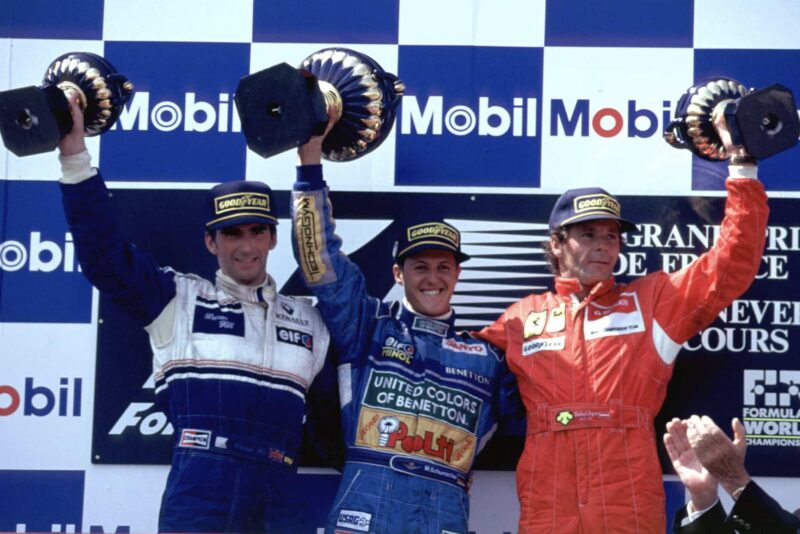
The podium finishers
Motorsport Images
Schumacher thus won his sixth out of seven 1994 races and looks well set to break Mansell’s nine-in-a-season record, but in the scrutineering bay afterwards HA Technical Delegate Charlie Whiting was insistent on taking a download of the Benetton’s telemetry for examination and analysis prior to the British GP. Instead, it was probably the vanquished Hill who came out of the weekend best of all. You can understand to an extent why Renault Sport has been less inclined to accord his words the same weight they might have Mansell’s, Prost’s or Senna’s in years gone by, when discussing their engine’s performance. Equally, though, you can appreciate why this slight has irritated the hell out of Damon. It therefore pleased him no end that his $1.5M team-mate had echoed his feedback on the power unit almost precisely. At a time when the speculation has already begun that David Coulthard might be Mansell or Alesi’s partner at Williams next year, that should bolster Hill’s resolve further as in the races to come he stakes his claim to retain his drive. In France he barely put a wheel wrong, and never said a public word of what he really thought about Williams letting itself get outsmarted on tactics by Benetton.
Whether you thought that Rothmans Williams Renault got value for its $1.5M depends on your point of view, but Frank Williams was adamant that the team had learned a lot from Mansell during qualifying. Probably it had, but it would have been a lot more cost-effective for Renault Sport if it had listened to Damon Hill in the first place. D.J.T.
